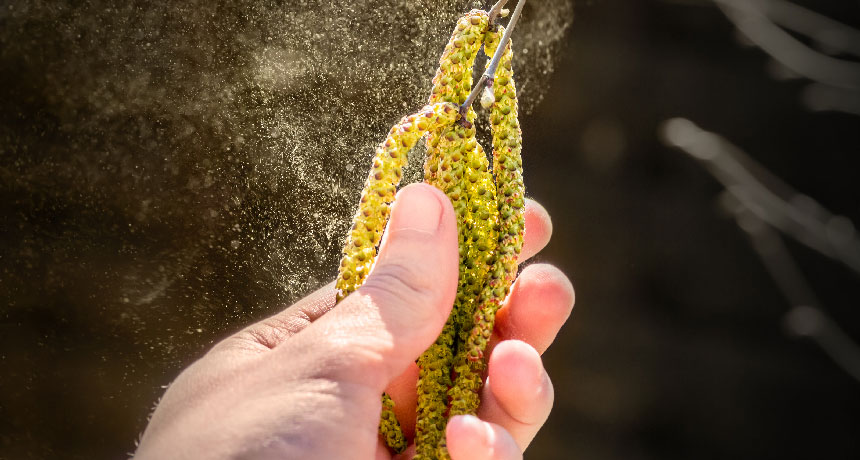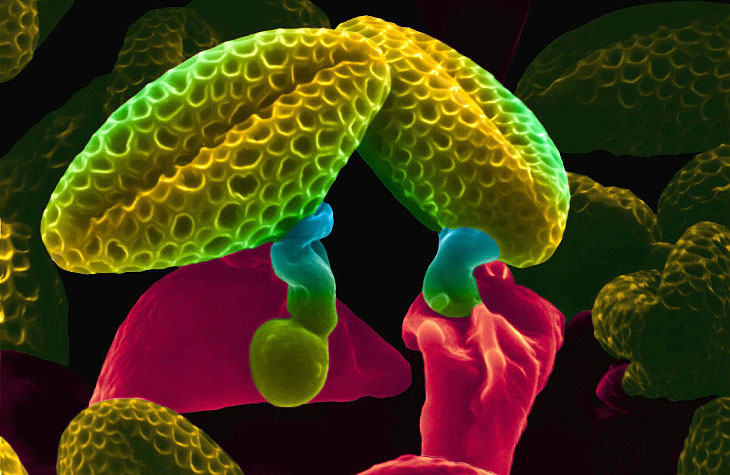How allergens in pollen help plants do more than make you sneeze
Clouds of the grains may be easy to hate, but they’re crucial for plant health

POOF! During allergy season, it’s hard not to take those puffs of pollen as a personal affront, but researchers are sorting out what plants get from their annoying-to-humans compounds.
Gregory_DUBUS/iStock/Getty Images Plus
“Are plants trying to kill us?” allergy sufferers often ask Deborah Devis.
A plant molecular geneticist at the University of Adelaide’s Waite campus in Australia, Devis should know the answer better than most. She is chugging through the last few months of a Ph.D. that involves predicting how grasses use pollen proteins that make people sneeze, wheeze and weep for days on end.
What’s known so far about what allergens do for pollens shed by grasses, trees and even mosses has nothing to do with revenge against a primate likely to attack them with mowers and other sharp tools, she says. Instead, plants are just trying to live like the rest of us.
“In most cases,” she says, “the allergen proteins are absolutely essential.”
To understand why, a refresher on some basics of plant sex is helpful. A pollen grain’s stripped-down mission is to carry male sex cells to female parts of flowers. It’s a chancy and dangerous job. But evolution has honed formidable chemistry that protects the grains’ travels and fertilization itself. For instance, the outer coat of a pollen grain contains the outstandingly tough sporopollenin, which can last thousands of years, says Hannah Banks of Kew Gardens in London. Just to clean debris off the coat, researchers routinely boil pollen in a mixture of sulfuric and acetic acid.
When a healthy pollen grain finally lands on the female part of a flower, a tube from the grain starts racing down through the female tissue to fertilize the plant’s version of an egg, an ovule. Wind-carried pollen wafting off flowers in great clouds is particularly competitive, Devis says. Tobacco pollen, delivered by insect, sometimes waits a while before starting to grow and can take up to 12 hours to form a tube long enough to reach an ovule. In comparison, when Devis sprouted some normally wind-carried rice pollen on a microscope slide, the pollen tubes were too long to fit her view within just 15 minutes.

Profilins, a group of plant proteins containing allergens, matter in high-stakes plant sex, and in particular, the development of those tubes. (Profilins pop up at some stage in all life-forms with a cell nucleus, even a kind of amoeba with a profilin that can trigger reactions in allergy skin-prick tests in people and airway inflammation in mice, researchers from the University of Pusan in South Korea found in 2018.)
Plants need profilins for such fundamental jobs as assembling filaments into a cell’s basic framework. And in experiments at Cornell University in tomato plants (not wind-pollinated but easy to handle in the lab), suppressing a profilin gene sabotaged pollen tubes. “The pollen tubes can’t grow very long because there is no structure in place to keep on growing,” Devis says.
Similarity among different plants’ versions of profilin is “very, very high,” which shows how evolutionarily crucial the proteins are for plants, Devis says. The similarity suggests that “it’s just impossible, or very improbable, for any offspring that has a variation of those profilins to even survive.”
Another source of allergies are pollen proteins called expansins, which loosen cell walls, thus easing a pollen tube’s push toward the ovary. Sabotaging them turns pollen largely impotent. Without the normal expansins, “pollen tubes are just not making it to the ovule,” Devis says. Instead “they’re kind of clumping.”
Still other groups of pollen proteins that plants find useful can also trigger allergens in people. For instance, proteins active in plants’ stress responses or a cell’s use of calcium have proved allergenic, says aerobiologist Annika Saarto of the University of Turku in Finland.
Better understanding allergens’ jobs in pollen could help anyone who wanted to tackle the complex job of trying to engineer low-sneeze grasses, birch trees or other beloved but vexing plants, Devis says. But as alluring a dream as it may be for allergy sufferers, making allergen-free plants has its challenges. Because of the allergens’ vital roles for pollen, researchers can’t just engineer the structures all away. Scientists would need to use their knowledge of allergen functions to find some less- or non-allergy triggering substitutes.
And while tweaking one plant variety might be doable — say taming some oak or olive that helped push 10 of Europe’s urban parks into the ranks of high-allergy provocation — making a whole landscape of pollen-spewing plants less sneeze-provoking is daunting. “Not in my lifetime,” Devis predicts.







